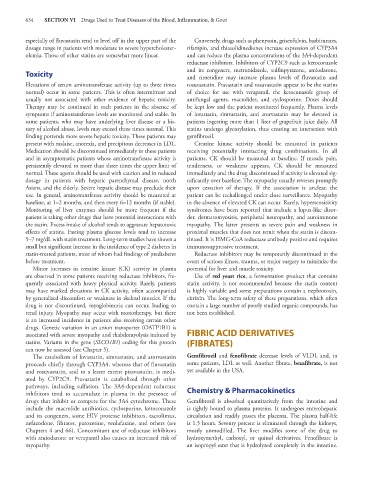Page 648 - Basic _ Clinical Pharmacology ( PDFDrive )
P. 648
634 SECTION VI Drugs Used to Treat Diseases of the Blood, Inflammation, & Gout
especially of fluvastatin tend to level off in the upper part of the Conversely, drugs such as phenytoin, griseofulvin, barbiturates,
dosage range in patients with moderate to severe hypercholester- rifampin, and thiazolidinediones increase expression of CYP3A4
olemia. Those of other statins are somewhat more linear. and can reduce the plasma concentrations of the 3A4-dependent
reductase inhibitors. Inhibitors of CYP2C9 such as ketoconazole
Toxicity and its congeners, metronidazole, sulfinpyrazone, amiodarone,
and cimetidine may increase plasma levels of fluvastatin and
Elevations of serum aminotransferase activity (up to three times rosuvastatin. Pravastatin and rosuvastatin appear to be the statins
normal) occur in some patients. This is often intermittent and of choice for use with verapamil, the ketoconazole group of
usually not associated with other evidence of hepatic toxicity. antifungal agents, macrolides, and cyclosporine. Doses should
Therapy may be continued in such patients in the absence of be kept low and the patient monitored frequently. Plasma levels
symptoms if aminotransferase levels are monitored and stable. In of lovastatin, simvastatin, and atorvastatin may be elevated in
some patients, who may have underlying liver disease or a his- patients ingesting more than 1 liter of grapefruit juice daily. All
tory of alcohol abuse, levels may exceed three times normal. This statins undergo glycosylation, thus creating an interaction with
finding portends more severe hepatic toxicity. These patients may gemfibrozil.
present with malaise, anorexia, and precipitous decreases in LDL. Creatine kinase activity should be measured in patients
Medication should be discontinued immediately in these patients receiving potentially interacting drug combinations. In all
and in asymptomatic patients whose aminotransferase activity is patients, CK should be measured at baseline. If muscle pain,
persistently elevated to more than three times the upper limit of tenderness, or weakness appears, CK should be measured
normal. These agents should be used with caution and in reduced immediately and the drug discontinued if activity is elevated sig-
dosage in patients with hepatic parenchymal disease, north nificantly over baseline. The myopathy usually reverses promptly
Asians, and the elderly. Severe hepatic disease may preclude their upon cessation of therapy. If the association is unclear, the
use. In general, aminotransferase activity should be measured at patient can be rechallenged under close surveillance. Myopathy
baseline, at 1–2 months, and then every 6–12 months (if stable). in the absence of elevated CK can occur. Rarely, hypersensitivity
Monitoring of liver enzymes should be more frequent if the syndromes have been reported that include a lupus-like disor-
patient is taking other drugs that have potential interactions with der, dermatomyositis, peripheral neuropathy, and autoimmune
the statin. Excess intake of alcohol tends to aggravate hepatotoxic myopathy. The latter presents as severe pain and weakness in
effects of statins. Fasting plasma glucose levels tend to increase proximal muscles that does not remit when the statin is discon-
5–7 mg/dL with statin treatment. Long-term studies have shown a tinued. It is HMG-CoA reductase antibody positive and requires
small but significant increase in the incidence of type 2 diabetes in immunosuppressive treatment.
statin-treated patients, most of whom had findings of prediabetes Reductase inhibitors may be temporarily discontinued in the
before treatment. event of serious illness, trauma, or major surgery to minimize the
Minor increases in creatine kinase (CK) activity in plasma potential for liver and muscle toxicity.
are observed in some patients receiving reductase inhibitors, fre- Use of red yeast rice, a fermentation product that contains
quently associated with heavy physical activity. Rarely, patients statin activity, is not recommended because the statin content
may have marked elevations in CK activity, often accompanied is highly variable and some preparations contain a nephrotoxin,
by generalized discomfort or weakness in skeletal muscles. If the citrinin. The long-term safety of these preparations, which often
drug is not discontinued, myoglobinuria can occur, leading to contain a large number of poorly studied organic compounds, has
renal injury. Myopathy may occur with monotherapy, but there not been established.
is an increased incidence in patients also receiving certain other
drugs. Genetic variation in an anion transporter (OATP1B1) is
associated with severe myopathy and rhabdomyolysis induced by FIBRIC ACID DERIVATIVES
statins. Variants in the gene (SLCO1B1) coding for this protein (FIBRATES)
can now be assessed (see Chapter 5).
The catabolism of lovastatin, simvastatin, and atorvastatin Gemfibrozil and fenofibrate decrease levels of VLDL and, in
proceeds chiefly through CYP3A4, whereas that of fluvastatin some patients, LDL as well. Another fibrate, bezafibrate, is not
and rosuvastatin, and to a lesser extent pitavastatin, is medi- yet available in the USA.
ated by CYP2C9. Pravastatin is catabolized through other
pathways, including sulfation. The 3A4-dependent reductase Chemistry & Pharmacokinetics
inhibitors tend to accumulate in plasma in the presence of
drugs that inhibit or compete for the 3A4 cytochrome. These Gemfibrozil is absorbed quantitatively from the intestine and
include the macrolide antibiotics, cyclosporine, ketoconazole is tightly bound to plasma proteins. It undergoes enterohepatic
and its congeners, some HIV protease inhibitors, tacrolimus, circulation and readily passes the placenta. The plasma half-life
nefazodone, fibrates, paroxetine, venlafaxine, and others (see is 1.5 hours. Seventy percent is eliminated through the kidneys,
Chapters 4 and 66). Concomitant use of reductase inhibitors mostly unmodified. The liver modifies some of the drug to
with amiodarone or verapamil also causes an increased risk of hydroxymethyl, carboxyl, or quinol derivatives. Fenofibrate is
myopathy. an isopropyl ester that is hydrolyzed completely in the intestine.

